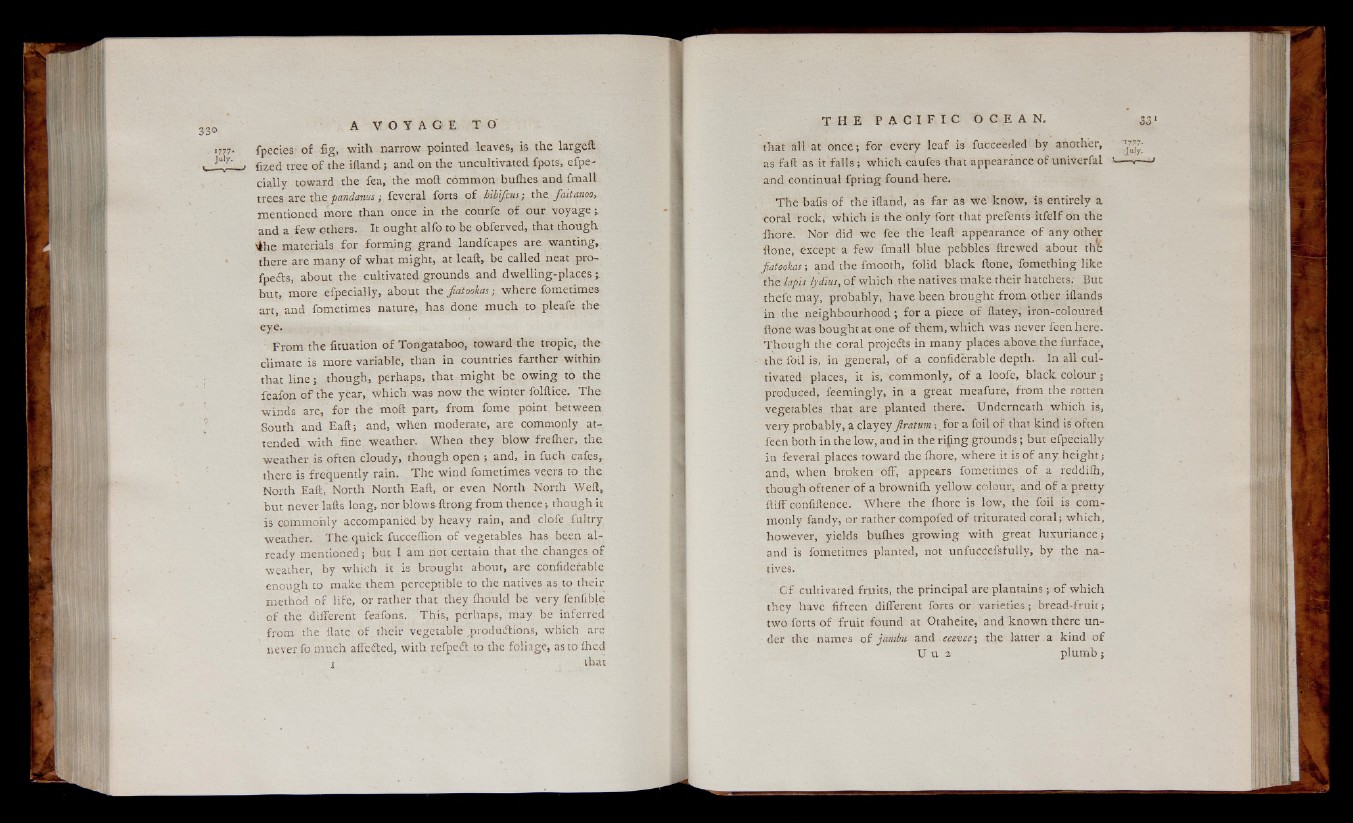
fpecies of fig, with narrow pointed leaves, is the largeft
iized tree of the ifland ; and on the uncultivated fpots, efpe-
cially toward the fea, the moft common bullies and fmall
trees are the pandanus ; feveral forts of hibi/cus; the. faitanoo,
mentioned more than once in the courfe of our voyage;
and a few others. It ought alfo to be obferved, that though
\4he materials for forming grand landfcapes are wanting,
there are many of what might, at leaft, be called neat pro-
fpefts, about the cultivated grounds and dwelling-places
but, more efpecially, about the fatookas; where fometimes
art, and fometimes nature, has done much to pleafe the
eye.
From the fituation of Tongataboo, toward the tropic, the
climate is more variable, than in countries farther within
that lin e ; though, perhaps, that might be owing to the
feafon o f the year, which was now the winter folftice. The
winds are, for the moft part, from fome point between
South and Eaft; and, when moderate, are commonly attended
with fine weather. When they blow freiher, the
weather is often cloudy, though open ; and, in fuch cafes,
there is frequently rain. The wind fometimes veers to the
North Eaft, North North Eaft, or even North North Weft,
but never lafts long, norblowsftrong from thence; though it
is commonly accompanied by heavy rain, and clofe fultry
weather. The quick fucceflion of vegetables has been already
mentioned; but I am not certain that the changes of
weather, by which it is brought about, are confiderablq
enough to make them perceptible to the natives as to their
method of life, or rather that they ihould be very fenfible
of the different feafons. This, perhaps, may be inferred
from the date of their vegetable productions, which are'
never fo much affc&ed, with refpeft to the foliage, as to ilied
i that
that all at once; for every leaf is fucceeded by another,
as faft as it falls ; which caufes that appearance of univerfal
and continual fpring found here.
The bails of the ifland, as far as we know, is entirely a
coral rock, which is the only fort that prefents itfelf on the
fhore. Nor did we fee the leaft appearance of any other
ftone, except a few fmall blue pebbles ftrewed about the
fatookas; and the fmooth, folid black ftone, fomething like
the lapis lydins, of which the natives make their hatchets; But
thefemay, probably, have been brought from other iflands
in the neighbourhood; for a piece of flatey, iron-coloured
ftone was bought at one of them, whifch was never feen here.
Though the coral projedts in many places above the furface,
the foil is, in general, of a confiderable depth. In all cultivated
places, it is, commonly, of a loofe, black colour ;
produced, feemingly, in a great meafure, from the rotten
vegetables that are planted there. Underneath which is,
very probably, a clayey flratum ; for a foil of that kind is often
feen both in the low, and in the rifing grounds; but efpecially
in feveral places toward the ihore, where it is o f any height;
and, when broken off", appears fometimes of a reddiih,
though oftener of a browniih yellow colour, and of a pretty
{tiff confidence. Where the ihore is low, the foil is commonly
fandy, or rather compofed of triturated coral; which,
however, yields buihes growing with great luxuriance;
and is fometimes planted, not unfuccefsfully, by the natives.
C f cultivated fr.uits, the principal are plantains; of which
they have fifteen different forts or varieties; bread-fruit;
two forts of fruit found at Otaheite, and known there under
the names of jambu and eeevee; the latter a kind o f
U u 2 plumb;